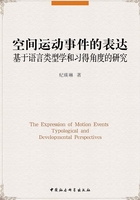
2.2 UNIVERSALITY VS.LANGUAGE-SPECIFICITYREGARDING SPACE IN CHILD LANGUAGE
Although a motion event can be analyzed into a universal set of semantic components (i.e.Path, Figure, Motion, Ground, Manner and Cause), languages greatly differ with regard to the grammatical elements used to express these components (e.g.verbs, particles, subordinated clauses, gerunds).This observation raises an important question in the domain of children's acquisition of spatial language, namely, which factor largely constrains children's learning of spatial expression? More specifically, is it universal pre-linguistic cognitive concepts about space or specific properties of a given language that a child is exposed to from the outset? Generally speaking, there exist two views on this question: the universal approach, stressing cognitive priority, and the language-specificity approach, which highlights the role of specific language input.